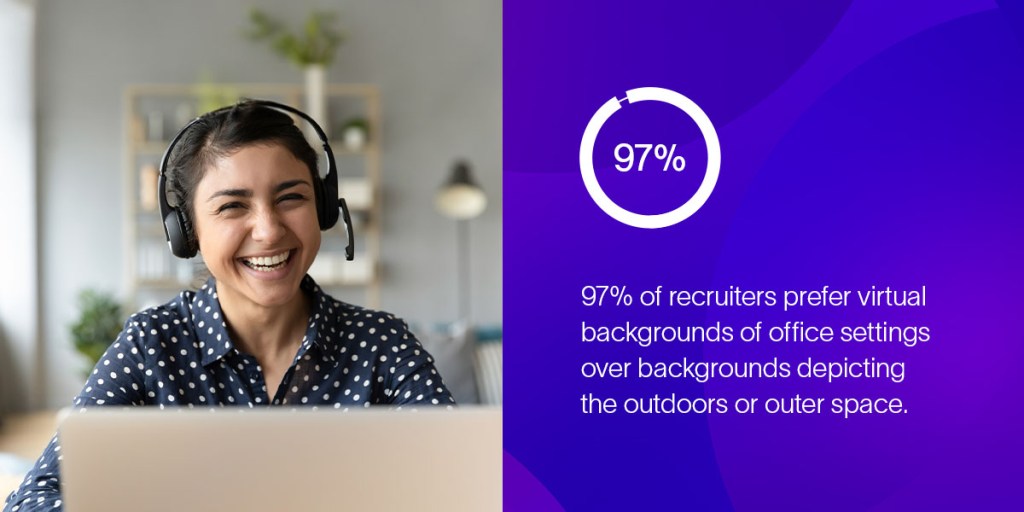Because of the rise of remote and hybrid work and other job market trends, virtual interviews have experienced a surge in popularity. They significantly decrease recruitment costs and make the process easier for the candidate and the recruiter. In fact, in a recent survey, 82% of employers said they used virtual interviews.
Virtual interviews eliminate in-person interactions, meaning candidates must rethink how to prepare for a video interview to put their best foot forward. With some simple tips and adjustments, these interviews can be engaging and productive.

Stay Confident and Prepared With These Virtual Interview Tips
Many employers choose this format to make the process more efficient for themselves and their candidates. A virtual interview follows many of the same rules as an in-person one. However, some significant differences exist. The following tips for virtual interviews will help candidates make a positive and meaningful impact on their interviewers.
1. Set up a Virtual Interview Space
A candidate’s virtual interview location forms part of the interviewer’s first impression. Candidates should find a clean, quiet, well-lit and clutter-free space, and the interviewer should have a clear, unobstructed view of the candidate’s face. Candidates can face a window if the interview occurs during the day. If not, they can place a lamp or light before them.
Candidates should also pay attention to what’s behind them. Ideally, they should avoid anything distracting that could shift the interviewer’s focus away from them. Candidates who feel concerned about their interview space can use a virtual background. These backgrounds should also be professional and simple — 97% of recruiters prefer virtual backgrounds of office settings over backgrounds depicting the outdoors or outer space.

2. Test the Technology
Unlike in-person interviews, virtual interviews rely on several technologies coming together, including audio, video and internet. Technical issues will likely fluster candidates and frustrate interviewers, making testing the technology essential.
Once candidates have set up in a quiet, well-lit interview space, they should test their technical setup. They can ask friends to participate in a video call using the same internet connection, headphones and camera. They should also familiarize themselves with the meeting platform and learn to perform basic actions, such as muting and unmuting the microphone.
Framing the shot is another consideration. Candidates should position the camera at eye level and ensure it’s within arm’s reach to frame the shot appropriately. They should ensure they don’t look too big or too small on camera. A good rule of thumb involves leaving some space at the top of the screen and keeping their head and shoulders visible.
3. Dress Professionally
Although interviewers can only see a candidate’s head and shoulders in a virtual interview, the candidate should dress as they would if they were interviewing in person. Studies show that well-dressed people feel more confident and respected by their colleagues.
In addition to selecting professional clothing, candidates must check their clothes work well on camera. Trying on clothes and sitting in front of the camera will highlight clothing that looks good in person but gives the wrong impression on camera.
4. Focus on Preparation
Candidates should take the following steps to ensure they’re ready for anything in an interview:
- Answer common interview questions: Preparing a list of likely questions and reviewing the answers helps ensure natural and comprehensive responses.
- Research the company and role: Candidates should gather information on the company’s strengths, mission and values. They must also understand what the role covers and the type of work they’ll do if they get the job.
- Prepare a list of questions: It’s easy to forget to ask the interviewer questions during an interview. Preparing a list of questions ensures candidates get the information they need while keeping the interview moving.
5. Remove Distractions
Virtual interviews provide ample opportunity for distractions. For example, if candidates do interviews at home, pets and children can draw their attention. And because these interviews take place online, candidates may contend with pop-up notifications and instant messages. Candidates can take the following steps to keep their interviews distraction-free:
- Turn off notifications.
- Switch phones to silent.
- Close email applications.
- Minimize as many windows as possible.
- Ask family or roommates to stay out of earshot.
- Keep pets in a different room.
Some platforms also have an option to mute background noise. Candidates can research the platform and take the necessary steps to keep the interviewer focused on them.
6. Navigate the Virtual Interview
Once thoroughly prepared, candidates must navigate the interview process calmly and confidently. The following tips can help make candidates look prepared and professional:
- Keep notes close: Candidates should have their resumes and notes available for reference throughout the interview. Because the interviewer can only see the candidate’s head and shoulders, having lots of detailed notes may seem tempting. However, candidates should only glance at their notes to avoid sounding like they’re reading. The conversation should sound natural.
- Maintain eye contact: Candidates should look into the camera as often as possible — not at themselves. It’s best to inform the interviewer beforehand if they plan to take notes.
- Keep an open and relaxed posture: Body language remains essential, even in a virtual interview. Candidates should aim to appear relaxed on camera. They can also use hand gestures.
- Pay attention to the interviewer: It’s common for candidates to get lost in monitoring their responses and failing to take in the interviewer’s body language. If the interviewer starts to look bored or distracted, the candidate should be aware of it so that they can change the pace of the interview.
7. Conduct a Post-Interview Follow-Up
Candidates should also plan what they’ll do after the interview to keep themselves at the top of the interviewer’s mind. The best practice involves sending a follow-up email within 24 hours, thanking the interviewer for their time and consideration. Candidates can use this communication to reiterate their interest in the position and highlight positive moments from the interview.
If the candidate hasn’t heard back from the interviewer after the agreed-upon time frame, they should follow up politely by email or phone, depending on the interviewer’s preference.
Virtual Interview FAQ
Since virtual interviews have grown in popularity, many candidates share the same questions about how to approach them. We’ve answered two of the most frequently asked questions here.
Should Candidates Blur Their Backgrounds for a Virtual Interview?
A candidate’s background gives an immediate impression of themselves and what matters to them. It can be distracting if it’s too cluttered, but if it’s just a plain white wall, it can also give the wrong impression. Candidates do not need to blur their backgrounds if they have a clean, well-lit space to interview. However, if the space feels cluttered or there’s a chance of distractions like people walking past, it may help to blur the background.
When Should Candidates Arrive for a Virtual Interview?
Logging on early to an interview is as important as arriving in good time for a face-to-face interview. Candidates should log on and launch a test meeting at least 15 minutes before the interview to test the Wi-Fi connection, webcam and audio.
Apply to Danaher Today and Drive Innovation That Improves Lives

If you’re ready to innovate every day and build a career that makes a meaningful difference, Danaher can help you every step of the way. With Danaher, you’ll take risks and work hard under the guidance of experienced leaders and the stability of a global organization. As global leaders in life sciences, diagnostics and biotechnology, we want to see others grow their skills in these fields.
Browse our job openings and take the first step to realizing life’s potential today!

Leave a Reply